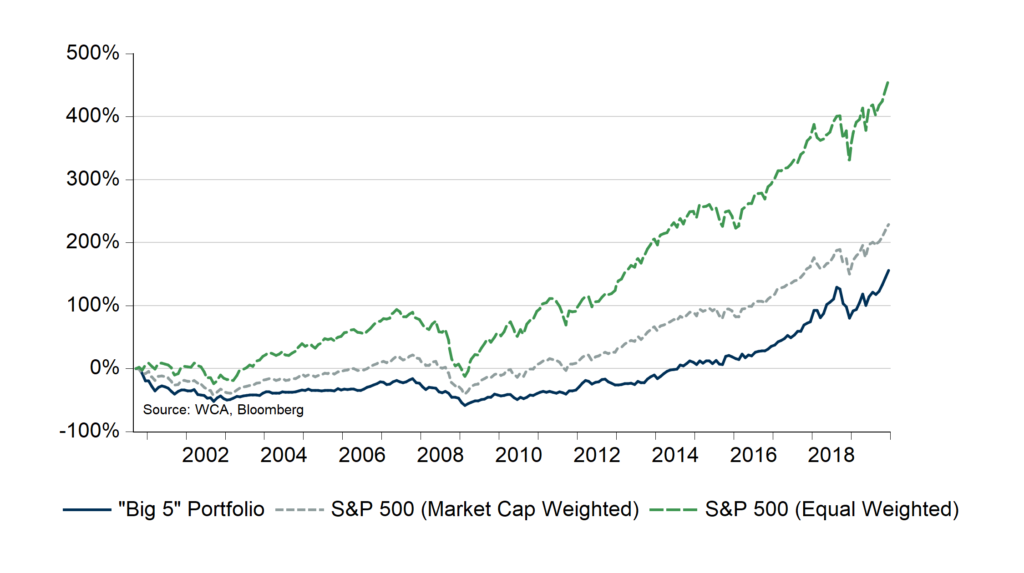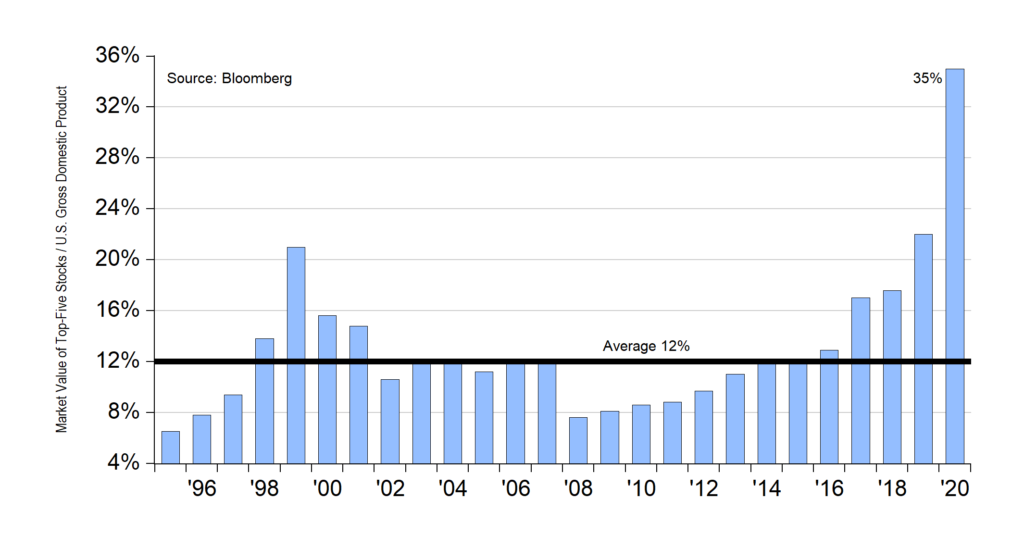Buying the Big Five?
Imagine an investment strategy wherein you might seek out the most successful and valuable companies. We will refer to this as the “big five” portfolio. Further, imagine that this “big five” portfolio bought the five most valuable companies in the Standard & Poor’s 500 index at each year’s end starting in 2000. Imagine further that this process was repeated each year ever since. How might this strategy of buying big and valuable stocks have done?
The strategy produced positive returns, but the journey would have been painful and frustrating (chart A, below). Investing in the “big five” at the start of each year would have returned over 155% by 2019. Yet the strategy would have been underwater with a negative return from 2000 through 2014. It would not have been until 2015 that gains would have begun to accumulate, and by that point, other simple strategies would have run far ahead. For example, the market-capitalization-weighted S&P 500 stock index was up 229%, and the equal-weighted S&P 500 index was up 458% from January 2000 through January 2020. Owning top-shelf and well-known names would not have turned out to be a very good strategy, after all.
Chart A
“Big Five” Strategy vs. S&P 500

A New Record
It is also interesting to keep an eye on how value the top five mega-cap stocks are relative to the economy’s size (chart B, below). To do this, we divide the total value of the five most valuable U.S. stocks by the country’s gross domestic product (GDP). Today, the five largest U.S. companies’ value is 35% of the U.S. economy — a record. The previous peak was 1999 when the five largest firms were valued at just over 20% of GDP.
Chart B
Market Capitalization of 5 Most Valued Stocks (% GDP)

To be fair, it must be noted that today’s mega-cap companies are extremely profitable. Fundamentally, the five largest companies produce revenue equal to roughly 5% of GDP — both in 2000 and now. But profitability by the “big five” are much greater today than back in 2000. Today the “big five” generated net profits equal to 14% of assets, twice the profitability of 2000. Producing more revenue and earnings with less capital marks a massive change in efficiency, mainly due to the shift toward a digital economy. To be fair, higher profits should fetch a higher valuation, but much of the higher profitability now seems priced in.
An Active Alternative
Investment strategies that systematically put more money in highly valuable stocks tend to struggle when markets become discriminating over price. Indices like the S&P 500 and many others are market-capitalization weighted. This means that highly valued firms are weighted more heavily in the index. When following such a process, it is helpful to remember that there can be drawbacks to size. Larger companies can become the target of anti-trust and regulatory pressure. Replicating past success and delivering high growth can become difficult with size, placing managements under intense pressure. Rapidly growing firms can end up with large and sprawling organizations and may increasingly turn to acquisitions to fund growth. All of these drawbacks can increase risk. For these reasons, it pays to maintain pricing discipline and avoid adding to positions just because the market assigns a high valuation to any one firm.
We believe the market-cap weighted nature of most market indices creates an opportunity for active management. An actively managed portfolio that focuses on factors other than market size can be one way to avoid some of the pitfalls that can come with owning very highly-valued stocks. As the “big five” companies in the U.S. approach a collective valuation near 35% of GDP, a record, it may make sense to consider an active approach.
S&P 500 — The Standard & Poor’s 500 Index is a capitalization-weighted index that is generally considered representative of the U.S. large capitalization market.
The S&P 500 High Beta Index measures the performance of 100 constituents in the S&P 500 that are most sensitive to changes in the market. Constituents are weighted relative to their level of market sensitivity, with each stock assigned a weight proportional to its beta.
The S&P 500 Low Volatility Index measures performance of the 100 least volatile stocks in the S&P 500. The index benchmarks low volatility or low variance strategies for the U.S. stock market. Constituents are weighted relative to the inverse of their corresponding volatility, with the least volatile stocks receiving the highest weights.
Disclosures:
The Washington Crossing Advisors’ High Quality Index and Low Quality Index are objective, quantitative measures designed to identify quality in the top 1,000 U.S. companies. Ranked by fundamental factors, WCA grades companies from “A” (top quintile) to “F” (bottom quintile). Factors include debt relative to equity, asset profitability, and consistency in performance. Companies with lower debt, higher profitability, and greater consistency earn higher grades. These indices are reconstituted annually and rebalanced daily. For informational purposes only, and WCA Quality Grade indices do not reflect the performance of any WCA investment strategy.
Standard & Poor’s 500 Index (S&P 500) is a capitalization-weighted index that is generally considered representative of the U.S. large capitalization market.
The S&P 500 Equal Weight Index is the equal-weight version of the widely regarded Standard & Poor’s 500 Index, which is generally considered representative of the U.S. large capitalization market. The index has the same constituents as the capitalization-weighted S&P 500, but each company in the index is allocated a fixed weight of 0.20% at each quarterly rebalancing.
The information contained herein has been prepared from sources believed to be reliable but is not guaranteed by us and is not a complete summary or statement of all available data, nor is it considered an offer to buy or sell any securities referred to herein. Opinions expressed are subject to change without notice and do not take into account the particular investment objectives, financial situation, or needs of individual investors. There is no guarantee that the figures or opinions forecast in this report will be realized or achieved. Employees of Stifel, Nicolaus & Company, Incorporated or its affiliates may, at times, release written or oral commentary, technical analysis, or trading strategies that differ from the opinions expressed within. Past performance is no guarantee of future results. Indices are unmanaged, and you cannot invest directly in an index.
Asset allocation and diversification do not ensure a profit and may not protect against loss. There are special considerations associated with international investing, including the risk of currency fluctuations and political and economic events. Changes in market conditions or a company’s financial condition may impact a company’s ability to continue to pay dividends, and companies may also choose to discontinue dividend payments. Investing in emerging markets may involve greater risk and volatility than investing in more developed countries. Due to their narrow focus, sector-based investments typically exhibit greater volatility. Small-company stocks are typically more volatile and carry additional risks since smaller companies generally are not as well established as larger companies. Property values can fall due to environmental, economic, or other reasons, and changes in interest rates can negatively impact the performance of real estate companies. When investing in bonds, it is important to note that as interest rates rise, bond prices will fall. High-yield bonds have greater credit risk than higher-quality bonds. Bond laddering does not assure a profit or protect against loss in a declining market. The risk of loss in trading commodities and futures can be substantial. You should therefore carefully consider whether such trading is suitable for you in light of your financial condition. The high degree of leverage that is often obtainable in commodity trading can work against you as well as for you. The use of leverage can lead to large losses as well as gains. Changes in market conditions or a company’s financial condition may impact a company’s ability to continue to pay dividends, and companies may also choose to discontinue dividend payments.
All investments involve risk, including loss of principal, and there is no guarantee that investment objectives will be met. It is important to review your investment objectives, risk tolerance, and liquidity needs before choosing an investment style or manager. Equity investments are subject generally to market, market sector, market liquidity, issuer, and investment style risks, among other factors to varying degrees. Fixed Income investments are subject to market, market liquidity, issuer, investment style, interest rate, credit quality, and call risks, among other factors to varying degrees.
This commentary often expresses opinions about the direction of market, investment sector, and other trends. The opinions should not be considered predictions of future results. The information contained in this report is based on sources believed to be reliable, but is not guaranteed and not necessarily complete.
The securities discussed in this material were selected due to recent changes in the strategies. This selection criterion is not based on any measurement of performance of the underlying security.
Washington Crossing Advisors, LLC is a wholly-owned subsidiary and affiliated SEC Registered Investment Adviser of Stifel Financial Corp (NYSE: SF). Registration with the SEC implies no level of sophistication in investment management.



